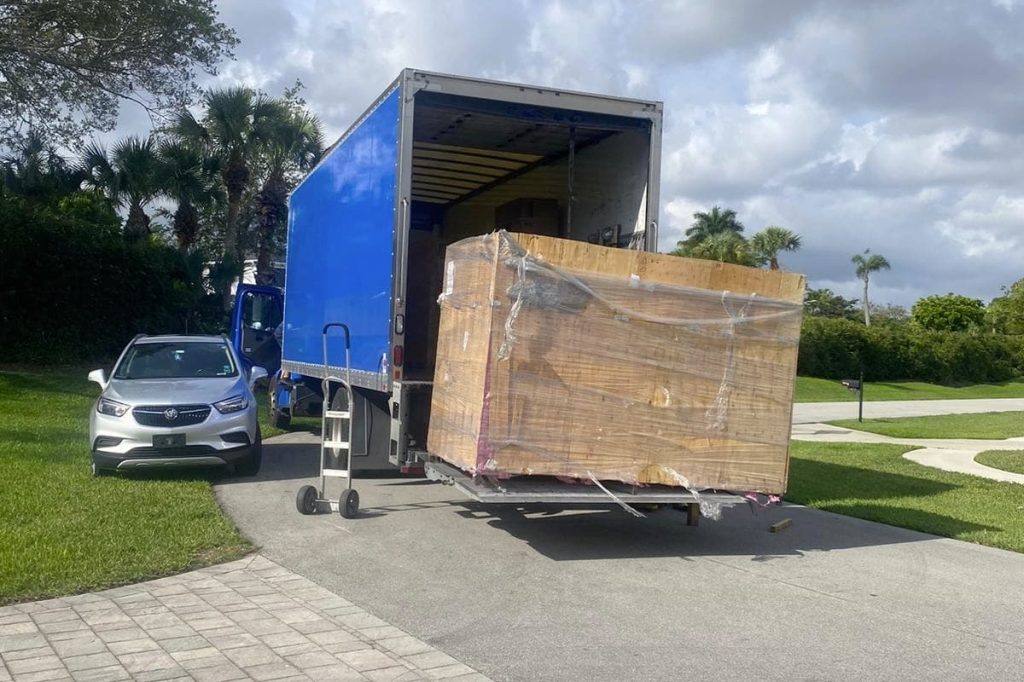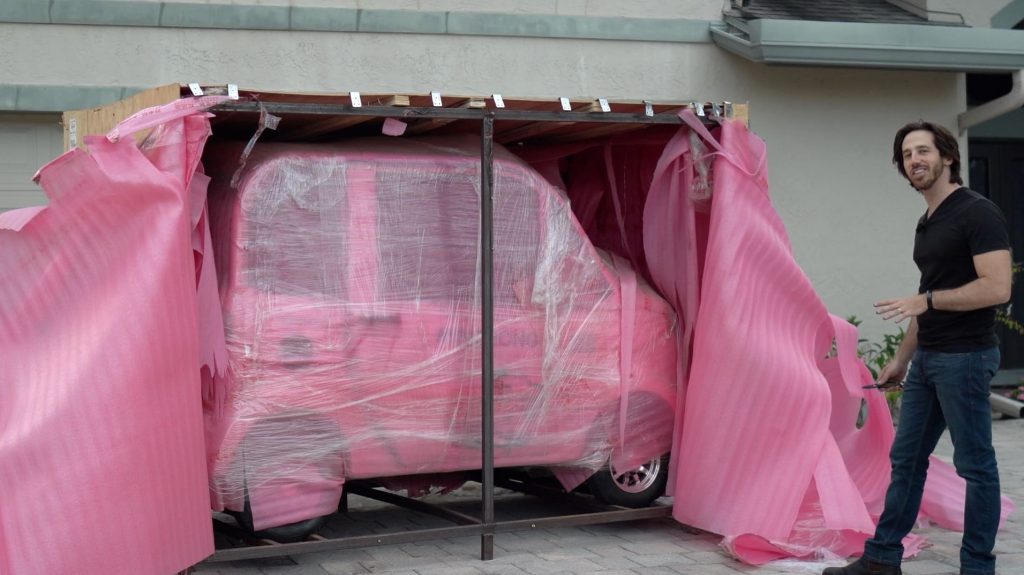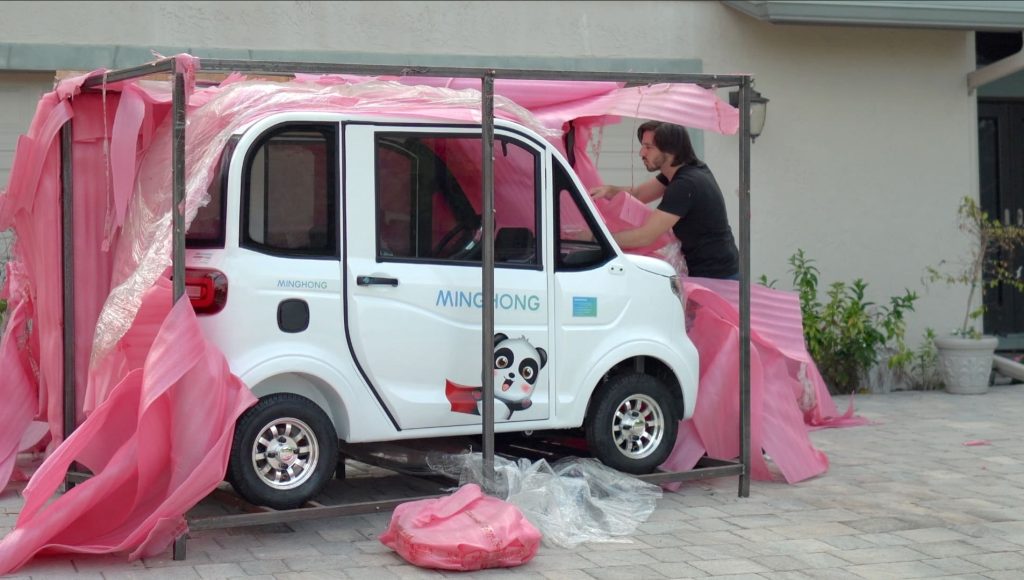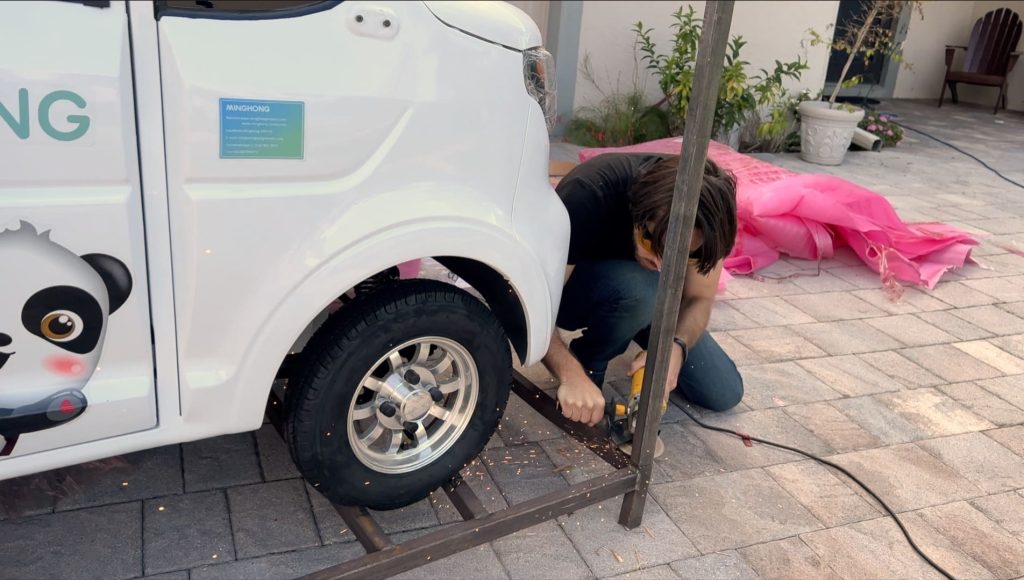
Believe it or not, a stranger in China sent a massive shipping crate to my house with what supposedly contained an electric micro-car. What would happen next was far from an ordinary Tuesday.
It all started with a strange message from someone in China. “Can we send you an electric car?”
For those who know me, that might not actually sound so strange.
If you don’t already follow my writing, then you might not know that I have two major passions. The first is electric micromobility, which spans everything from electric bikes and e-scooters to electric motorcycles and other rideables. But my other more eccentric passion involves all the weird little electric vehicles produced in China for the local Chinese market. I’m not talking “real” cars. I’m talking about the weirder stuff. I write a weekly column about my interesting window-shopping finds, such as three-wheeled electric RVs and tiger-shaped e-buses.
I’ve even made a bad habit of putting my money where my mouth is, which is how I wound up with such awesome toys as a $2,000 electric mini-truck and a $1,000 five-seater electric boat, among other oddities.

Somehow I’ve become something of the guru for imported weird Chinese EVs, which I guess is how this internet stranger found me.
I’ll call her Katherine because that’s her name, or at least her English name. Katherine explained that she works for a Chinese manufacturer known as Minghong. They make all sorts of small electric vehicles, such as micro-cars, tuk-tuks, mini-trucks and more. They claim an annual production of 120,000 vehicles, so they must not be a small potato in the Chinese mini-EV market. Katherine had seen one of my Chinese micro-vehicle unboxing videos that racked up 10 million views on YouTube, and she asked if I wanted to make a similar video for their electric micro-car to see what kind of quality Minghong can produce.
“Sign me up!” was my response.
Several long weeks later, I watched a box truck roll up to my family’s Florida driveway and unload one of the jankiest-looking shipping crates I’d ever seen.

Armed with a knife and a power drill, I went to work.
After shucking layers of plywood with seemingly unnecessary three-inch staples sticking through into the air, followed by layer after layer of foam wrapping, I finally arrived at the treasure inside: an adorable little white micro-car enclosed in a steel tube cage.
The adorable 7’9” long (236 cm) electrical vehicle, adorned on each side with a big flying Panda in a cape, seemed to have arrived more or less in good shape.
There was some slight body damage at the rear, but considering the vehicle was still protected inside a steel cage, I assume that happened at the factory.



Since I was a few thousand miles from home and using my family’s driveway, I had to knock on the neighbors’ doors and beg my way to a borrowed angle grinder so I could cut the cage away from the car. After a half-hour of delicate, high-speed metalwork later, I had four of the smallest automotive tires I’d ever seen sitting on the pavement. See my full video for the unboxing process in glorious Technicolor.
The battery was unfortunately empty due to the switch being left in the “On” position during its long sea voyage to the US. But luckily, they included an oddly high-powered 1,500W charger, filling the 60V 50Ah lithium battery in around 2.5 hours. Most of these micro-cars come with much weaker chargers, but this one was a beauty.

After an initial charge of the battery, I took the maiden drive solo so I wouldn’t risk anyone else with my silly shenanigans. Unfortunately, that also meant I couldn’t share the joy with any other delighted souls. The accelerator was surprisingly smooth as I blasted through the neighborhood, using all 3,000W of power I had at my disposal. Windows down and wind in my hair, I put that pedal to the plastic and was rewarded with the roaring “whir” of the rear axle-mounted motor.
To be fair, the acceleration may be smooth, but it isn’t particularly quick. But then again, neither is the braking.
There are only two brakes, one on each rear wheel. They’re hydraulic disc brakes, but they still require a bit more leg force than a traditional car to activate. Despite not having as powerful of an effect as modern power brakes, they worked decently well. I never felt like I didn’t have enough braking power; I just knew I had to step on the pedal harder than in a typical car. I’d say that makes sense since this is anything but a typical car.
The sole rear braking feature also meant that later in the day, after a rain, I could power slide around turns by locking the rear wheels up midturn. Several rainy days (and the fact that I had to park outside) also proved that the door weatherstripping worked great, keeping the car bone dry inside.

I should also mention a note here about street legality: This is absolutely NOT a street-legal vehicle in most of the US. You might be able to get away with it in communities that make exceptions for golf carts. (Think Georgia’s Peachtree City, Florida’s Key Biscayne, or other similar communities where golf carts reign supreme.) You’ll never be able to register this as an LSV (low-speed vehicle) at your local DMV since it doesn’t meet the Federal Motor Vehicle Safety Standards for these types of micro-cars in the US. And so I don’t condone using such nonlegal vehicles on public roads. But for science, I did just that. I stayed on small neighborhood roads where it was difficult to even get up to the MingHong’s 25 mph (40 km/h) limit, so I wasn’t putting myself or anyone else at much risk. But again, I don’t condone using a nonlegal vehicle on public roads.
But after testing it myself and discovering that it actually drives really well, I decided it was time to load up my nieces and nephews and cruise the neighborhood.


The little car, which appears to be the S1 Pro model from Minghong, is set up with a single wide driver’s seat and a rear bench for passengers.
I found that I could fit three kids on the rear bench and that my wife and I could comfortably fit in the driver’s bench at the same time since it was so wide. With five people in the car, performance wasn’t even that hindered, though I was definitely driving more conservatively with that much precious cargo on board.
The steering wheel is set up for center drive and, thus, is in the middle of the car. Strangely though, the pedals are offset to the right, as if the rest of the car was intended to be right-hand drive. It’s not too much of an issue when you’re alone in the cockpit since your right foot controls the pedals, and the car simply isn’t that wide anyway. But when sharing the frontbench, you wind up steering with the wheel slightly off to your left side. I thought it would feel weird, but frankly, the entire vehicle is so weird that the fact that I wasn’t sitting directly behind the steering wheel didn’t strike me as particularly odder than anything else.
The kids definitely enjoyed the rides and had fun waving to their friends and all the onlookers as we cruised the hood. Throughout a week of use, we even managed to fit the Minghong into several local errands, such as taking my nephew to his soccer game at the local community park, hitting up the pool, and other short local trips that didn’t require bringing a “real” car into the mix. When using the Minghong by myself, I made use of the folding feature in the rear bench seat to create more storage space, kind of like a hatchback (just without the hatch in back).

The Minghong has passed most of my tests quite well. It takes some getting used to, and it has some drawbacks.
There’s no air conditioning, though the massive windows and the sunroof with dual ventilation fans help keep plenty of air moving through the vehicle.
The door handles are really far back on the doors, to the point where you have to reach behind your shoulder to grab them, but that seems to be necessitated by the simple door latch design on the long doors that provide access to the rear seat as well.
I wasn’t really digging the panda paint job, though I get that Asian car aesthetics skew more toward cartoons and pastels than the typical American auto fashion. I took some liberties and decided to do a bit of vinyl wrap work to update the appearance to something a little more to my liking. Big thanks to my sister for help there, as she has a lot more vinyl wrap experience than I do. I don’t have the GPS data to prove it, but I feel like the racing stripes added a solid two to three more miles per hour to the top speed.



I’m not exactly sure what Minghong’s play was here, sending me a micro-car. I don’t think they’re expecting a large American market, especially since their vehicles aren’t street-legal in the US (and since you can already buy some awesome street-legal electric micro-cars for reasonable prices in the US). But perhaps they’re hoping to make a name for their factory in order to reach folks in countries where these Chinese micro-cars can be imported and used legally.
And I hope they weren’t counting on me falsely glorifying their vehicle. If so, they’ll be disappointed to hear that I shared how the rear bench literally fell off its hinge the second time I lifted it up, as seen in my video. So I’m not going to sugarcoat this thing: even though it’s super fun and useful, the build quality leaves something to be desired in a few areas.
But I never felt like the mechanics weren’t solid. The suspension is pretty decent; it’s got solid rack and pinion steering, hydraulic disc brakes, a backup camera, auto glass (though only certified to the Chinese standard, not USDOT), full lighting, mirrors, windshield wiper with washer fluid reservoir, Bluetooth music player, etc. It even has machined aluminum wheels instead of cheap steel rims. There are some nice touches here.
I have absolutely no idea what this vehicle costs, though my own experience doing personal imports tells me that the final dent in your American bank account would be around four times the factory price on the window sticker or Alibaba page.

The whole experience basically reinforced two things for me: Electric micro-cars are incredibly fun and convenient vehicles, and that Minghong builds a decent car.
I’ve already been a huge fan of electric micro-cars for years, basically ever since getting my first one. And after testing a couple of micro-car models from New York-based Wink Motors, I can tell that a wave of tiny electric cars is destined to descend on the US. There’s just too much utility here to ignore them. They’re cheap, fun, effective, easy to park, take up a fraction of the garage or parking space, and basically deserve a larger audience than they currently enjoy. But I’m sure that audience will be growing, and quickly.
Author: Micah Toll
Source: Electrek




Top comment by doug champion
Liked by 5 people
the racing stripes added a solid two to three more miles per hour to the top speed.
At the minimum. Plus they look great. Carol Shelby would approve(well maybe not).
View all comments